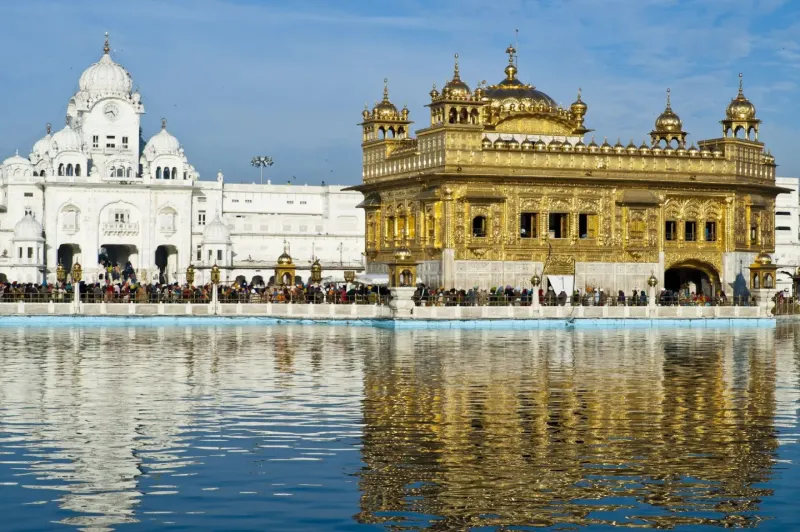
Golden temple is one of the most sacred and popular pilgrimage sites for Sikhs. The temple is situated in the city of Amritsar in Punjab state of India. It is also known as Harmandir Sahib or Darbar Sahib. The temple was built by Guru Arjan Dev in the 16th century. The temple complex has a number of other buildings and monuments. The temple is surrounded by a large pond called the holy tank or pool. Pilgrims take a dip in the tank before entering the temple.
The Golden Temple, also known as Sri Harmandir Sahib, is a prominent Sikh gurdwara located in the city of Amritsar, Punjab, India. The temple is built around a man-made pool (sarovar) that was completed by Guru Ram Das in 1577. Guru Arjan – the fifth Sikh Guru – oversaw the construction of the temple, and installed the Guru Granth Sahib – the holy scripture of Sikhism – inside the temple in 1604. The Golden Temple has become a symbol of the Sikh religion and is considered to be one of the most sacred places in Sikhism.
Read more >> The London Eye: A Unique Experience
The Golden Temple has a long and rich history. The site of the temple was first sanctified by Guru Nanak – the founder of Sikhism – in the 15th century. Guru Nanak is said to have had a vision of the divine being, who instructed him to build a temple at the site. Guru Nanak passed away in 1539, and his successor, Guru Amar Das, began construction of the temple in 1570. Guru Amar Das' son, Guru Ram Das, completed the temple in 1577.
During the early years of the Sikh Empire, the Golden Temple was a target of persecution by the Mughal rulers. In 1762, the temple was attacked and destroyed by the Afghan ruler, Ahmad Shah Durrani. The temple was rebuilt in 1809 by Maharaja Ranjit Singh, the founder of the Sikh Empire.
During the British Raj, the Golden Temple was once again attacked, this time by the British Army during the Sikh War of 1848. The temple was badly damaged, but was repaired and restored by the Sikh leader, Maharaja Ranjit Singh.
After the Partition of India in 1947, the Golden Temple was attacked by Hindu mobs during the communal violence that broke out. The temple was badly damaged, but was rebuilt and reopened to the public in 1951.
The Golden Temple continues to be a sacred place of pilgrimage for Sikhs from all over the world. Every year, millions of Sikhs visit the temple to pay homage to their religious traditions and to receive blessings from the Guru Granth Sahib.
Structures Inside The Golden Temple
There are many structures inside the Golden Temple, including
1.The Darshani Deori
The Darshani Deori is the main entrance to the Golden Temple in Amritsar, India. It is a beautiful, ornate structure that was built in the early 1600s. The Darshani Deori is the first thing that visitors see when they enter the temple complex. It is a symbol of the Sikh faith and a place of worship for Sikhs.
2.The Akal Takht
The Akal Takht is the supreme seat of authority of the Khalsa and the central shrine of the Sikhs. It is located in the Harmandir Sahib complex in Amritsar, Punjab, India. The Akal Takht was built by the sixth Sikh Guru, Guru Hargobind, in 1606. The Akal Takht is the highest seat of temporal authority of the Khalsa and the primary seat of the Sikh Parliament. It is also known as the "Throne of the Timeless One".
3.The Guru Granth Sahib
The Guru Granth Sahib is the holy scripture of Sikhism, and is considered to be the final and eternal guru of the Sikhs. It is a voluminous text of 1430 pages, and contains the teachings of the Sikh Gurus, as well as other saints and sages from different religions and regions. The text is mainly in Gurmukhi, with some sections in Persian and Hindi. The Guru Granth Sahib is the property of the Sikh people, and is cared for by the Sikh community. It is normally kept in the Harmandir Sahib, also known as the Golden Temple, in Amritsar, Punjab, India.
4.The Guru Granth Sahib Jiwan
The Guru Granth Sahib Jiwan is the holy book of the Sikh religion. It is the final and perpetual guru of the Sikhs. It was compiled and composed by the sixth Sikh guru, Guru Har Gobind, and contains the sacred writings of the Sikh gurus and other saints. The Guru Granth Sahib Jiwan is the central object of worship in Sikhism and is considered the supreme authority on Sikh beliefs and practices.
5.The Bir
The Bir in Golden Temple is a beautiful and holy place for Sikhs. It is a place where they can go to worship and learn more about their faith. The Bir in Golden Temple is also a place where Sikhs can go to meditate and connect with their God.
6.The Sarovar
The Sarovar at the Golden Temple is a holy pool of water located in the Punjab region of India. The Sarovar is said to have been built by the fourth Sikh Guru, Guru Ram Das. The Golden Temple itself is located in the city of Amritsar, which is the spiritual and cultural center of the Sikh religion. The Sarovar is an important part of Sikh worship and is used for ceremonial ablutions. The Sarovar is also a popular spot for pilgrims to take a dip in, as it is believed that the water has healing properties.
7.The Langar
Langar is a communal free kitchen where people of all religions and backgrounds are welcome to eat. The langar at Golden Temple is particularly famous and serves tens of thousands of people every day. The kitchen is run entirely by volunteers, and the food is vegetarian.








Showing 0 verified guest comments